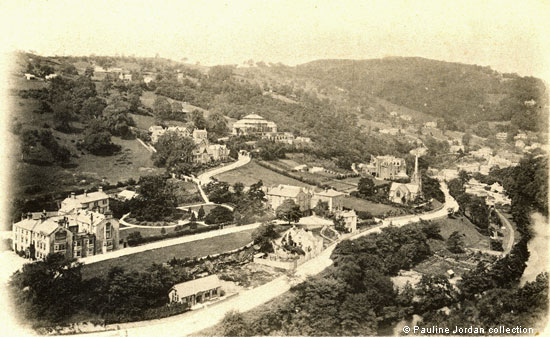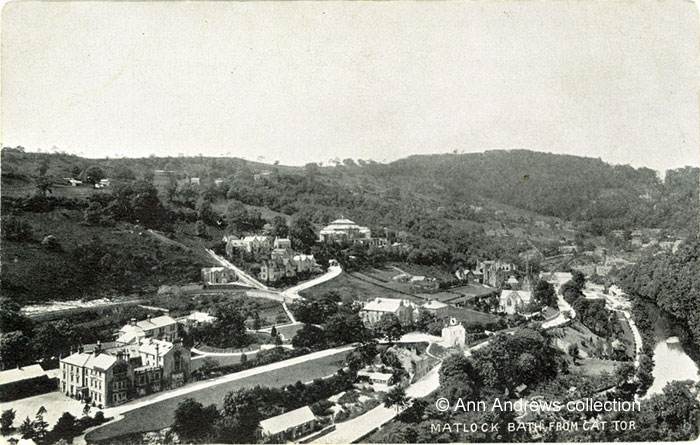|
Images Index> Matlock Bath, 20th and 21st Century Images> This page |
| Matlock Bath: New Bath Hotel (2) |
| Matlock Bath : Twentieth Century Photographs, Postcards, Engravings & Etchings |
|
||||||||||||||||||||||||
In 1910 the hotel experienced some financial problems, which were obliquely referred to in the Derby paper. "One does not like to hear of an old establishment like the New Bath Hotel, at Matlock Bath, encountering any of the worries or anxieties that vex most mundane institutions. The New Bath is not the oldest Inn in the Matlocks, but it can, of course, boast a very considerable measure of antiquity. Sixty years ago it was known as Ivatt's and Jordan's .... has recently undergone great alterations, been refurnished, and other improvements carried out. The gardens, which are tastefully laid out, and adorned with shrubs and flowers, contain a magnificent lime tree"[1]. There is photographic evidence of the staked tree (unfortunately not available), which Henry Moore[2], Thomas Tyack[3] and William Adam[4] described as resembling a Banyan tree! The garden plants from Thomas Tyack's times, as well as the lime tree, are discussed in his "Famous Derbyshire Health Resorts - The Matlocks"[3]. According to another report, the lime tree at Matlock Bath developed from a twig of a tree under which Napoleon used to sit at St. Helena, pondering his dramatic downfall[5]. An early visitor to the hotel described the tree in a poem as covering about a rood of ground and with branches being supported by forty nine stakes. Some time before 1910 a tremendous wind storm had swept through the hotel's grounds, and the lime tree suffered considerable damage[1]. The tree still looks huge in this picture, indicating that the original photograph for this card was taken before the tree was damaged[6]. On 19 July 1912 what remained of the tree was blown down, leaving only the stump[6]. What is interesting in later pictures of the hotel, after the pool was built in 1934, is that you can still see the curve of the path where the tree had been.
Bottom right, on the banks of the river, are the Derwent Gardens with the relatively newly open Switchback Railway in the grounds. At the end of the gardens closest to the camera is what appears to be a vegetable garden and a small building, whilst at the other end of the Derwent Gardens are the buildings of the Ferry House and the Fishpond Stables which were later demolished to make way for the Grand Pavilion.
There is more about the New Bath Hotel
|
||||||||||||||||||||||||
1. "Matlock Bath, from Jacob's Heights" [sic].The caption is incorrect as the picture was taken from Cat Tor. No publisher details provided. Inland ½d stamp, foreign 1d. Unposted. Postcard in the collection of and provided by and © Pauline Jordan. 2. "Matlock Bath from Cat Tor". Published by Jno. M. White, Derwent Arcade, Matlock Bath. Derwent Series. Phototyped in Berlin. Unused. Stamp box: Inland ½d. Foreign 1d. 3. "Matlock Bath From Cat Tor". Published by Photochrom Co. Ltd, London. No number. Unused. Researched, written by and © Ann Andrews. Intended for personal use only |
||||||||||||||||||||||||
References (coloured links are to more information elsewhere on this web site): [1] "Derby Daily Telegraph", 8 November 1910. [2] Read Henry Moore (1818) "Picturesque Excursions From Derby to Matlock Bath", pp.27 - 32 [3] See "Famous Derbyshire Health Resorts. The Matlocks, about 1892 - Part 1". I have seen a photograph of the staked tree, but I d not own a copy (web mistress). [4] Adam, W. (1857, 6th edition) "The Gem of the Peak; or Matlock Bath and Its Vicinity". ... [5] "Derby Mercury", 1 August 1900. [6] "Derby Daily Telegraph", 26 July 1912. [7] "Derbyshire Times and Chesterfield Herald", 29 August 1891. Brewster Sessions. [8] Reminiscences of the late Mr. Frank Clay, from his private papers and notes owned by the web mistress. [9] "Derby Mercury", Wednesday,
21 Aug 1895. One of George Marsden's lengthy advertisements about
the sale.. |
||||||||||||||||||||||||









 Read the
Read the 












